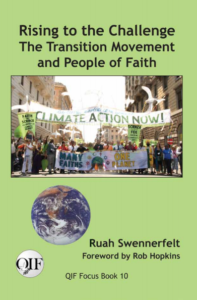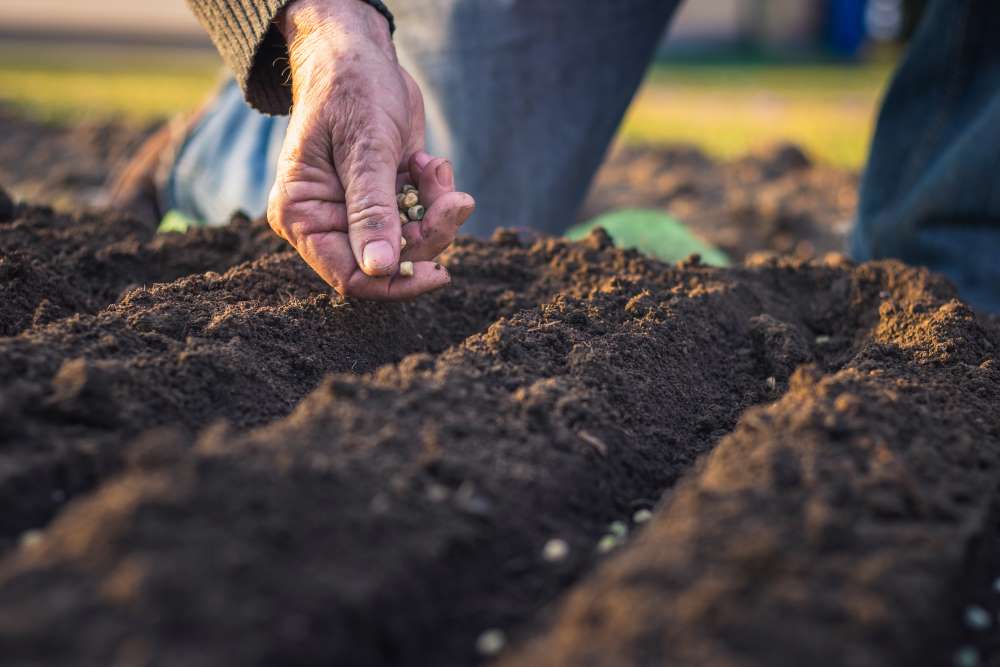Rising to the Challenge: The Transition Movement and People of Faith
Reviewed by Brian Drayton
November 1, 2016
 By Ruah Swennerfelt. Quaker Institute for the Future Focus Book 10, 2016. 111 pages. $15/paperback; free PDF available at quakerinstitute.org.
By Ruah Swennerfelt. Quaker Institute for the Future Focus Book 10, 2016. 111 pages. $15/paperback; free PDF available at quakerinstitute.org.
Buy from QuakerBooks
The Transition movement is rapidly becoming a significant international vehicle for deep, nonviolent, democratic social change, as community groups around the world study together about what a sustainable future will require and start to build their versions of that future. Though many Friends are involved, many more are unaware of the movement’s history, goals, and extent. Ruah Swennerfelt’s book, slim but rich, is an ideal primer and invitation to individuals and to learning groups—in meetings, churches, or neighborhoods.
In the introduction, the author recounts how her spiritual journey, to and with Friends, enriched her engagement and activism for peace and other causes, and how she came to see that earthcare was in a sense an all-embracing context for other spiritual and social concerns. She recounts in brief compass her deepening search to understand what it would mean to live in right relationship with the earth, and the changes she made to live consistent with her new understanding. This naturally enough led to engagement with issues of importance in her community, and her growing insight about Quaker spirituality kept her attentive to inward as well as outward growth. During this years-long practice, she encountered the Transition movement for the first time, and soon joined with it.
I recount this introduction at some length because it is so reminiscent of early Quaker accounts, in which seekers like Hooton, Nayler, Dewsbury, and Fox followed independent paths which converged in the Quaker movement of the 1650s. The integrity of these independent evolutions added strength and a constructive diversity to the emerging “people,” and encouraged both endurance and creativity. Something similar may be happening with the Transition movement, at a time when external circumstances—climate change, the biodiversity crisis, the oncoming demise of the fossil-fuel economy, and the temptations to address the resulting social instability with authoritarian rule—make such a movement a perfect response to its times.
Chapter 1 explores the challenge of “being faithful in a changing world,” recounting responses among faith communities around the world to the crisis of the Anthropocene Era. These communities—Christian, Buddhist, Muslim, and others—bring the resources and insights of spirituality to the work of social change; perhaps most important is their awareness of the need for “inner transition” and all the work that entails.
Chapter 2 describes the rise of interest in permaculture and its contributions to the Transition movement. Though this approach took its name as a portmanteau of “permanent agriculture,” it has been recast as “permanent culture,” emphasizing an ethic of earthcare and people-care, supported by the use of surpluses of materials, food, or labor to build a sustainable (“permanent”) system of food production. Along with that comes sustainable community life, work, and celebration. Two permaculture pioneers, Rob Hopkins and Naresh Giangrande, worked together to found the first Transition initiative, in Totnes, England. The idea spread quickly in Great Britain, giving rise to the Transition Network, an important tool for organizing and mutual support.
Chapter 3 describes the growth and maturation of the movement’s vision. There are as many ways of implementing the Transition vision as there are communities experimenting with it, and the Transition movement is aware that it is “one way forward.” Pluralism of approach is a necessary outgrowth of the movement’s emphasis on local creativity, study, and experimentation, and the awareness and nurture of local socio-ecological systems and lifeways.
Chapter 4 represents the heart of Swennerfelt’s research, as it recounts her visits to or study of many different Transition initiatives in Ireland, Sweden, Italy, Brazil, and France. We hear the voices of “transition people” telling both what they are up to and how they got started. Chapter 5 steps back to examine core principles of earthcare, human-care, and constructive, sustainable living, as represented in Quaker, Jewish, Catholic, Muslim, and other faith traditions. Chapter 6, “Rising to the Challenge with Innovation, Creativity, and Love,” uses a case study to show how the movement can build its impact and inclusiveness. The Mid-Atlantic Transition Hub (MATH) did this by linking several Transition initiatives to share learning, resources, and community-building activities. We hear too about the Repair Café in Pasadena, Calif., which “brings together ‘fixers’ and community members to repair used and broken items”—a vision for right-use, earthcare, and community life, translated into literal nuts and bolts and know-how shared.
Swennerfelt’s practical and engaging book ends with the big question we are all facing: where does hope lie? She writes, “How can we be hopeful when we see the rise of mass shootings . . . the trend of unjust actions and killing of unarmed black men by increasingly militarized police? . . . When the sea levels continue to rise, and the planet continues to unravel with no end in sight? Finding rays of hope in the midst of all this is the work of Transition Towns.” And she concludes with a forward-looking description: “Without the label of ‘faith,’ the Transition Movement [in which many people of faith are working] is a faithful community of people, respecting one another and Earth, looking for a transition from a fossil-fuel-based consumer society, to one that cares deeply for healthy relationships, walks gently on the earth, and rises to action on behalf of all that lives.”



Comments on Friendsjournal.org may be used in the Forum of the print magazine and may be edited for length and clarity.